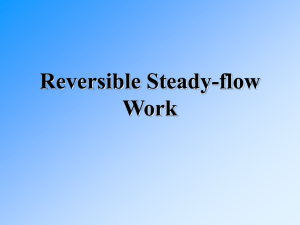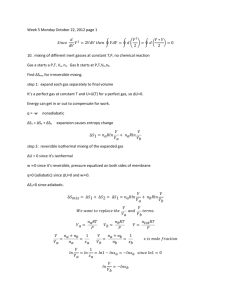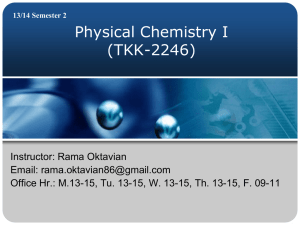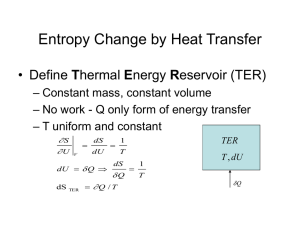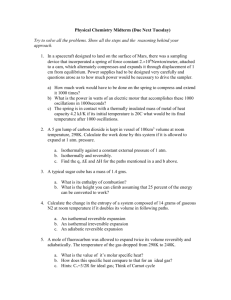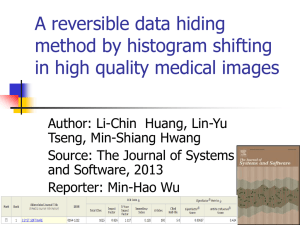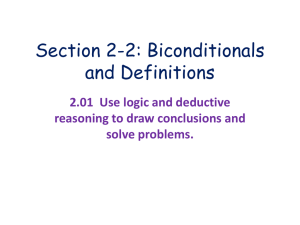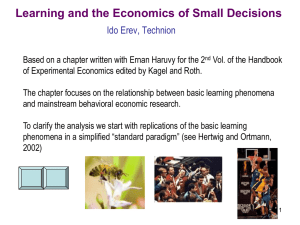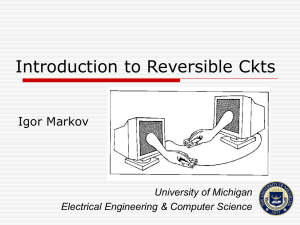October 17, 2012
advertisement
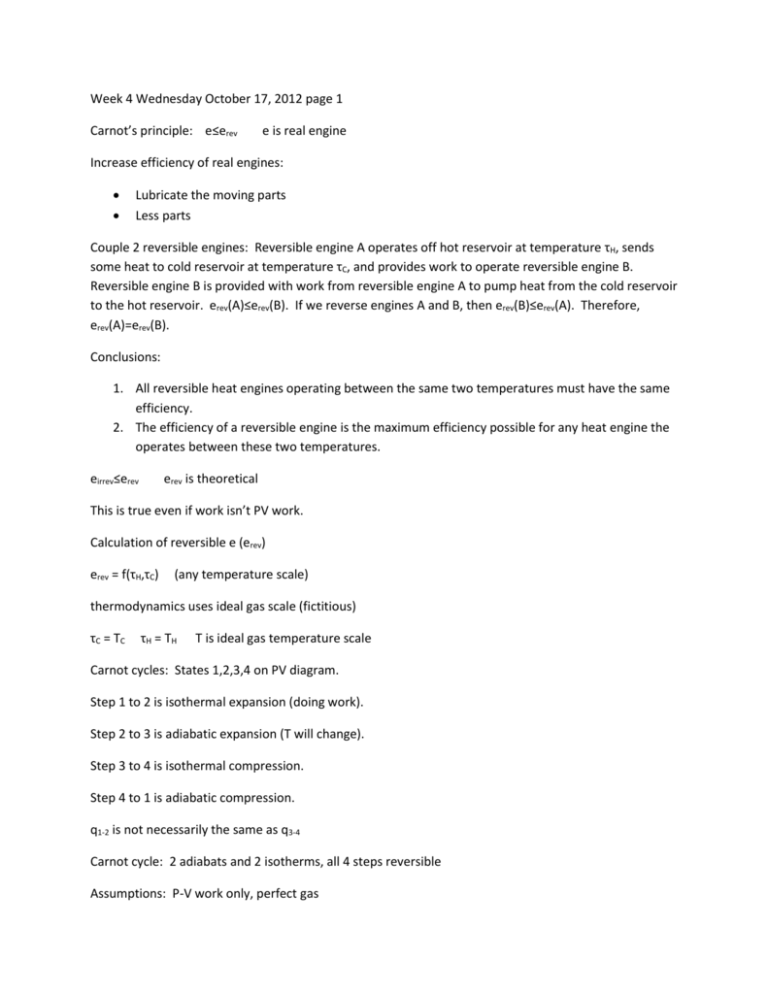
Week 4 Wednesday October 17, 2012 page 1 Carnot’s principle: e≤erev e is real engine Increase efficiency of real engines: Lubricate the moving parts Less parts Couple 2 reversible engines: Reversible engine A operates off hot reservoir at temperature τH, sends some heat to cold reservoir at temperature τC, and provides work to operate reversible engine B. Reversible engine B is provided with work from reversible engine A to pump heat from the cold reservoir to the hot reservoir. erev(A)≤erev(B). If we reverse engines A and B, then erev(B)≤erev(A). Therefore, erev(A)=erev(B). Conclusions: 1. All reversible heat engines operating between the same two temperatures must have the same efficiency. 2. The efficiency of a reversible engine is the maximum efficiency possible for any heat engine the operates between these two temperatures. eirrev≤erev erev is theoretical This is true even if work isn’t PV work. Calculation of reversible e (erev) erev = f(τH,τC) (any temperature scale) thermodynamics uses ideal gas scale (fictitious) τ C = TC τ H = TH T is ideal gas temperature scale Carnot cycles: States 1,2,3,4 on PV diagram. Step 1 to 2 is isothermal expansion (doing work). Step 2 to 3 is adiabatic expansion (T will change). Step 3 to 4 is isothermal compression. Step 4 to 1 is adiabatic compression. q1-2 is not necessarily the same as q3-4 Carnot cycle: 2 adiabats and 2 isotherms, all 4 steps reversible Assumptions: P-V work only, perfect gas 1st law: dU = dq + dw = dq – PdV since dw = -PdV for a reversible process dU = CVdT CVdT = dq – PdV 𝑛𝑅𝑇 𝑑𝑉 𝑡ℎ𝑒𝑛 𝑑𝑖𝑣𝑖𝑑𝑒 𝑒𝑣𝑒𝑟𝑦𝑡ℎ𝑖𝑛𝑔 𝑏𝑦 𝑇 𝑉 𝐶𝑉𝑑𝑇 = 𝑑𝑞 − 𝐶𝑉𝑑𝑇 𝑑𝑞 𝑛𝑅 = − 𝑑𝑉 𝑇 𝑇 𝑉 𝑠𝑖𝑛𝑐𝑒 𝑇 ≠ 0, 3𝑟𝑑 𝑙𝑎𝑤 𝐶 (𝑇)𝑑𝑇 𝑑𝑞 𝑛𝑅 ∮ 𝑉 =∮ −∮ 𝑑𝑉 𝑇 𝑇 𝑉 ∮ 𝑖𝑠 𝑎 𝑐𝑙𝑜𝑠𝑒𝑑 𝑖𝑛𝑡𝑒𝑔𝑟𝑎𝑙 𝑡ℎ𝑒 ∮ 𝑛𝑅 𝑑𝑉 𝑡𝑒𝑟𝑚 𝑖𝑠 0, 𝑠𝑖𝑛𝑐𝑒 𝑉 𝑖𝑠 𝑎 𝑠𝑡𝑎𝑡𝑒 𝑓𝑢𝑛𝑐𝑡𝑖𝑜𝑛 𝑉 The closed integral of a product of state functions is 0, like ∮ 𝑃𝑉 = 0 ∮ 𝑑𝑙𝑛𝑉 = 0 𝑠𝑖𝑛𝑐𝑒 𝑉 𝑖𝑠 𝑎 𝑠𝑡𝑎𝑡𝑒 𝑓𝑢𝑛𝑐𝑡𝑖𝑜𝑛 ∮ 𝐶𝑉(𝑇) 𝑇2 𝑇3 𝑇4 𝑇1 𝑑𝑇 𝑑𝑇 𝑑𝑇 𝑑𝑇 𝑑𝑇 = ∫ 𝐶𝑉(𝑇) + ∫ 𝐶𝑉(𝑇) + ∫ 𝐶𝑉(𝑇) + ∫ 𝐶𝑉(𝑇) 𝑇 𝑇 𝑇 𝑇 𝑇 𝑇 𝑇 𝑇 𝑇 1 2 3 4 The T1 to T2 term = 0 since it’s isothermal. The T3 to T4 term = 0 since it’s isothermal. ∫ 𝑇3 𝑇2 𝐶𝑉(𝑇) 𝑇𝐶 𝑇𝐻 𝑑𝑇 𝑑𝑇 𝑑𝑇 = ∫ 𝐶𝑉(𝑇) = − ∫ 𝐶𝑉(𝑇) 𝑇 𝑇 𝑇 𝑇 𝑇 𝐻 𝑇1 ∫ 𝑇4 𝐶𝑉(𝑇) 𝐶 𝑇𝐻 𝑑𝑇 𝑑𝑇 = ∫ 𝐶𝑉(𝑇) 𝑇 𝑇 𝑇 𝐶 ∴∮ ∮ 𝑑𝑞𝑟𝑒𝑣 =0 𝑇 2 3 4 1 𝑑𝑞𝑟𝑒𝑣 𝑑𝑞 𝑑𝑞 𝑑𝑞 𝑑𝑞 =∫ +∫ +∫ +∫ =0 𝑇 1 𝑇𝐻 2 𝑇 3 𝑇𝐶 4 𝑇 The state 2 to 3 term = 0 since it’s adiabatic. The state 4 to 1 term = 0 since it’s adiabatic. 1 2 1 4 ∫ 𝑑𝑞 + ∫ 𝑑𝑞 = 0 𝑇𝐻 1 𝑇𝐶 3 𝑞𝐻 𝑞𝐶 + =0 𝑇𝐻 𝑇𝐶 𝑞𝐶 𝑇 =− 𝐶 𝑞𝐻 𝑇𝐻 𝑒𝑟𝑒𝑣 = |𝑤| 𝑞𝐻 + 𝑞𝐶 𝑞 𝑇 = =1+ 𝐶 =1− 𝐶 𝑞𝐻 𝑞𝐻 𝑞𝐻 𝑇𝐻 𝑇 𝑒𝑟𝑒𝑣 = 1 − 𝐶 𝑇𝐻 That formula is true for any working substance. It shows that a higher TH will make the process more efficient. It shows that a lower TC will make the process more efficient. The cyclic integral equaling 0 means that it’s a state function. Arbitrary cycle on a PV diagram: Let a and b be points on the cycle near each other. Let m be a point on the same reversible adiabat as point a and point n be a point on the same reversible adiabat as point b such that m and n are on the same reversible isotherm. Let c be the point on the cycle that is also on the same reversible adiabat as point a. Let d be the point on the cycle that is on the same reversible adiabat as point b. Let point r be a point on the same reversible adiabat as point c and point s be on the same reversible adiabat as point d such that r and s are on the same isotherm. Notice that the area from points a and m to the point where curve ab intersects curve mn is the same area from points b and n to the point where curve ab instersects curve mn. This means that the area under path amnb is equal to the area under path ab. The area amnb is thus the reversible work done on the system. Likewise, the area under ab is also the reversible work done on the system. wamnb = wab ∆U = q + w and qam = 0 since am is an adiabat qbn = 0 since bn is an adiabat qamnb = qmn = qab qrs = qcd The cycle is mnsr back to m.
